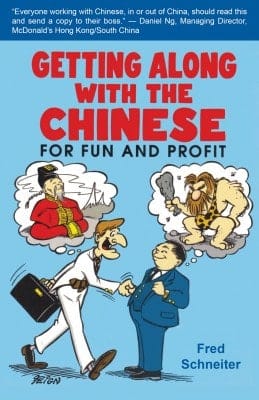Fred Schneiter spent 30 years working in and around China, and came to recognise the value of keeping an open mind and learning something new every day. You’re likely to learn something too if you read this excerpt from his book, Getting Along with the Chinese.
Chinese Mice Don’t Eat Cheese
IN THE EARLY DAYS of our wheat food promotion in Asia, the story was the same virtually everywhere. People didn’t eat bread because it was terrible. The best that could be said for it was that it kept your hands clean when you ate a sandwich.
Except for what passable fare you might encounter at one of the few new international hotels, hamburgers throughout the Orient defied digestion. The common practice was to prepare them early in the morning (using ingredients of questionable parentage) and then let them stew through the day in a sunny display case until they took on a hard, oily inedibility, with the lettuce acquiring the texture of wet tissue. Asians quickly decided they didn’t like hamburgers. They said they preferred rice, and I had to confess that in Asia, I’d rather eat rice too. Before long our industry was working closely with McDonald’s to establish a beachhead in South Asia. Properly prepared and presented, hamburgers had to be a hit there. After all, a mix of relish, mustard and ketchup is about as close as you can get to sweet and sour sauce without using a Chinese recipe.
I wasn’t surprised when Taiwan’s China Post reported later, “When the first Big Mac was served in Taipei on January 28, 1984 few would have imagined that in less than three years, Taiwan would be transformed into a veritable fast-food jungle with over forty-two fast-food chains vying for the public’s food dollar.” Not only was it affording a more balanced diet to people who’d been eating as much as 300 pounds of rice a year, the new merchandising system (the article noted) introduced “quality control and sanitation procedures.” Seven years later, I journeyed by train just across the border from Hong Kong to Shenzhen to participate in the opening of the first McDonald’s outlet in the People’s Republic of China. Marketing experts were awed to find the entire week’s inventory sold out in less than three hours. Within weeks that McDonald’s had become one of Shenzhen’s top tourist attractions.
The acceptance of properly prepared and correctly marketed hamburgers illustrates how—by identifying a circumventible consumer attitude and working aggressively toward improved quality, wheat foods have become a staple in Asia’s more developed countries. In urban centers like Hong Kong and Singapore, in stores and shops where food is prohibited, it is now common to see a sign with a line-drawing of a hamburger with a diagonal red slash across it. A decade ago people would have had trouble working out what the picture was supposed to represent.
In the early days of our marketing efforts, we ran a consumer study in Singapore and found Chinese there had only a vague idea of what foods are made with wheat. In Manila, I asked the five-year-old son of a Chinese friend if he knew what noodles were made from. “Worms!” he giggled. And that was the best guess he and his seven-year-old brother could come up with. (Today I find that less surprising than I did back in the 1960s, since a recent survey revealed that half of adult Americans don’t know that white bread is made from wheat.)
In our early Asian efforts, by looking beyond what consumers thought they thought, it was possible to develop a multi-billion dollar annual market among an Asian clientele which, at the outset, wasn’t at all interested in the product. In China for example, a decade after the opening of our market development program, wheat consumption doubled as better quality, more convenient and more varied wheat foods became available and purchases of US wheat were reaching a billion dollars a year.
If you work at it, it’s possible to discover something new about China and the Chinese virtually every day. And this may come from the most unlikely quarter. Years ago in Taiwan I learned something from a mouse which had taken up residence in our home during one of the cold winters which the island experiences, despite its straddling the Tropic of Cancer.
As soon as we became aware of the furry intruder I bought a little wire mesh cage, which traps the mouse alive, and baited it with a piece of cheese. Several days later, with the Cheddar still untouched, a deliveryman noticed the arrangement and said sagely with the waggle of a finger, “Chinese mice not eat cheese.”
While it’s widely “understood” Chinese don’t like cheese, it hadn’t occurred to me the same might hold true for the mice. But the idea did have a ring of truth. If there was no cheese in the home, even a reasonably intelligent mouse might have trouble figuring out it was supposed to go into the cage to eat something it had never before encountered. There had to be a reason why our beady-eyed little boarder hadn’t been enticed so far. Rather than having baited a trap it appeared all I was really doing was airing some cheese. I asked the deliveryman what a Chinese mouse might prefer. “Fish,” he said confidently, “with soy sauce.” I’d somehow never thought of a mouse eating fish or that one might prefer it with a dash of soy sauce. In fact, that’s about the last thing I’d have thought of using. As he went out the door he added, “Mouse like little ginger on fish.”
I replaced the cheese with a little leftover fish laced with a touch of soy and, of course, shredded ginger. Finding this more to his liking, our uninvited little freeloader was soon apprehended. It was an endorsement of the universal wisdom, “When in Rome do as the Romans do,” which in its Chinese version is, “When visiting a village ask how the villagers do things.”
There’s another Taiwan mouse story which illustrates the importance of not taking anything for granted in Asia. My wife Charlene, who was vice-principal of the Taipei American Elementary School at the time, mentioned that a number of mice were being caught around her office. I asked if they were being caught alive and she confirmed they were. I suggested that might account for the good hunting, noting that followers of some Asian religions, on capturing a cobra in the house, for example, would be inclined to release it alive in the garden. Might the school possibly be dealing with only a couple of mice, which, following their capture, are liberated in the playground to return for another fish-and-ginger treat? “That has crossed my mind,” she said. “I’m checking the mouse ‘disposal squad’ in the morning.” She returned home the following day with a grand grin and a fresh story of enlightenment. The mice were, in fact, being effectively dispatched. The dispatcher was an alligator.
“A what?”
“An alligator,” she replied. “They feed the mice to an alligator.”
“Where?”
“In the motor pool.”
“The school has an alligator in the motor pool?”
“My reaction exactly,” my wife said firmly. “When I heard that, I marched right over there and said, ‘I want to see the alligator.’ ”
“That’s a great opening line. I bet it got their attention.”
“Actually,” she replied, “they were pretty casual. They asked, ‘What alligator?’ I described the function of the one I had in mind and they said, ‘Oh! You mean that alligator.’ ” With that point cleared up, the motor pool crew showed her the large metal tank where the knobby creature was kept and explained it was only a temporary arrangement, as the alligator was actually collateral for a debt someone owed one of the crew. She advised them to find a new depository for the collateral and to come up with a less innovative but equally effective system for dispatching the mice. (It’s imperative in Asia to have an inquiring mind and to ask questions . . . or you may discover too late that someone nearby is raising an alligator.)
* * *
The belief that Chinese don’t care for cheese has been embraced by Chinese and Westerners alike, but it’s not quite true. It’s another one of those things where a little unlearning will get you nearer the truth. If you ask someone in China whether they “like cheese” you’re virtually assured of a negative answer. Except for ice cream, dairy products have not been widely available or particularly popular in the past. In reality, Chinese aren’t much inclined toward a “whiffy” Western cheese. But that shouldn’t be surprising. After all, supermarkets in America carry relatively little of the smelly stuff in comparison to the mild varieties. But while Chinese seem confounded by those of us who relish a chunk of stuff which smells like a Ming dynasty camel saddle, a sniff of their own “stinky doufu” bean curd delivers an uppercut that would jolt the senses of a rhinoceros.
An example of their low tolerance for our smelly cheese involved a friend, who on arriving at his hotel in Beijing, discovered he’d picked up the wrong bag at the airport. His bag contained some particularly sniffy cheese which he was bringing to European friends, and when he phoned the airport to inquire about it he learned the bag was there in the customs office. He said he’d pick it up the next day, but the official response to that was, “No! You come pick it up right now.” He did and he didn’t have to open it for customs inspection.
But it doesn’t necessarily follow that someone doesn’t like cheese simply because they don’t care for the smell of a particularly lusty one. In fact, the Chinese produce their own varieties. In Kunming, I purchased a white, very mild sheep cheese from a curbside vendor from the hill country. Just north of Macau I discovered a cheese-like fermented bean curd which, pressed into flat paper-thin wafers, is popular as a topping for rice porridge. Its refreshing zippy tang is on par with Europe’s best. In a Mongolian yurt I’ve eaten a heavily sugared hard white cheese, and in the high country near the Russian border nomads provided a midday snack of local bread with chunks of hard sour-milk cheese. Anywhere in China that you find goats, yak or sheep you’ll find cheese.
It was this question of Chinese and cheese which provided the unlikely catalyst for one of South Asia’s recent outstanding business success stories. Up until the early 1970s, pizzas were available in only a few international hotels, and a couple of Italian restaurants scattered between Manila and Singapore. The patrons were mostly local or visiting foreign aficionados.
Pizza’s lack of pizazz suggested either South Asians just didn’t care for the product or there was a good market potential ready to be pursued. Suspecting the latter, Shakey’s agreed to test the product in Taiwan in cooperation with our organization. The market study was to hinge largely on the reaction of passers-by in downtown Taipei, who would be invited to sample pizza and evaluate it. If the test was a success, a vigorous marketing thrust would introduce pizza throughout the region.
 One of the key questions in the initial draft of the survey asked people’s reaction to the cheese topping. I warned that if respondents knew that the topping was melted cheese, they would say they didn’t like it, which would “confirm” that South Asia lacked a market potential for pizza.
One of the key questions in the initial draft of the survey asked people’s reaction to the cheese topping. I warned that if respondents knew that the topping was melted cheese, they would say they didn’t like it, which would “confirm” that South Asia lacked a market potential for pizza.
The question was rephrased, “How do you like the sauce?” The Chinese loved it and the first franchised pizza outlet opened in Taipei soon after. Pizza Hut estimated in 1991 that in Hong Kong alone, the pizza industry sold a total of 3.4 million pizzas annually, which adds up to more than 100 tons of cheese consumed with gusto.
By taking a closer look at what everyone had always said was true about the Chinese and cheese we found that it really wasn’t correct after all. The new perspective launched a major food industry in Asia, creating thousands of jobs and bringing consumers pleasure, a new convenience, and a more balanced diet. The South China Morning Post noted sales of Western-style fast foods in Hong Kong are among the highest per-capita in the world today. Where a dozen years ago you had to know your way around to find a decent hamburger, consumption of them by Hong Kong’s seven million souls now is estimated to be in excess of 1.5 million per week.
In China never take anything at face value. As with the “fact” of Chinese not liking bread or cheese, remember, appearances can be deceptive.
That’s why the Chinese say: Don’t adjust your shoes in a neighbor’s melon patch.






Leave a reply